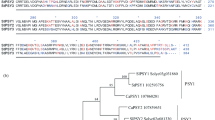Summary
The shrunken (sh) locus on chromosome nine in maize has been considered to be endosperm specific at the biochemical and the phenotypic levels of expression. The recent evidence concerning the presence of Sh encoded transcripts in the seedling (Springer et al. 1985) led us to examine this aspect at the protein level. The results from immuno-blot analyses show that the Sh encoded sucrose synthetase-1 protein (SS-1) is indeed present in seedlings. The expression of the gene SS-1 in seedling roots is verifiable by two criteria: 1) Various sh-null mutants that lack the SS-1 protein in the developing endosperm are also devoid of this protein in seedling root extracts. Only a single band, presumably encoded by the SS-2 locus, is seen in these mutants. 2) The electrophoretic variant of the sh mutant encoding a slow migrating SS-1 protein in the endosperm exhibits a concomitantly altered pattern of SS isozymes in seedling roots. A notable feature of SS-1 and SS-2 expression is that a unique tissue specific difference between endosperm and seedling roots is retained. The Sh root extracts show a total of five SS isozymes due to protomeric interaction of the SS1-SS2 tetramers present in the same cell. Endosperm extracts of the same genotype show only SS-1 and SS-2 homomers. The lack of heteropolymers is indicative of spatial and/or temporal separation of SS-1 and SS-2 expression in the endosperm cells. We suggest that these observations provide a new dimension and a useful tool for the analysis of many sh mutants and their revertants due to various transposable elements.
Similar content being viewed by others
References
Akazawa T, Okamoto K (1980) Bio-synthesis and metabolism of sucrose. In: Preiss J (ed) The biochemistry of plants. Academic Press, New York London, pp 199–218
Brewbaker JL, Upadhya MD, Makinen Y, Macdonald T (1968) Isoenzyme polymorphism in flowering plants III gel electrophoretic methods and applications. Physiol Plant 21:930–940
Chourey PS (1981) Genetic control of sucrose synthetase in maize endosperm. Mol Gen Genet 84:372–376
Chourey PS, Nelson OE (1976) The enzymatic deficiency conditioned by the shrunken 1 mutation in maize. Biochem Genet 14:1041–1055
Chourey PS, Nelson OE (1979) Interallelic complementation at the sh locus in maize at the enzyme level. Genetics 91:317–325
Chourey PS, Schwartz D (1971) Ethyl methanesulfonate induced mutations at the Sh 1 protein in maize. Mutat Res 12:151–157
Echt CS, Chourey PS (1985) A comparison of two sucrose synthetase isozymes from normal and shrunken maize. Plant Physiol (in press)
Hoefer P (1983) The separation of serum proteins on non-denaturing discontinuous gels. Hoefer Scientific Instruments, Craftsman Press, Seattle, WA, pp 96–104
Geiser M, Weck E, Doring HP, Werr W, Courage-Tebbe U, Tillman E, Starlinger P (1982) Genomic clones of a wild-type allele and a transposable element-induced mutant allele of the sucrose synthetase gene of Zea mays L. EMBO J 1:1455–1460
Jolly SO, McIntosh L, Link G, Bogorad L (1981) Differential transcription in vivo and in vitro of two adjacent maize chloroplast genes: The large subunit of ribulose biphosphate carboxylase and the 2–2 kilobase gene. Proc Natl Acad Sci USA 78:6821–6825
Kiesselbach TA (1949) The structure and reproduction of corn. University of Nebraska College of Agriculture Agricultural Experiment Station, Res Bull 161:1–96
Liu TT, Shannon JC (1981) A nonaqueous procedure for isolating starch granules with associated metabolites from maize (Zea mays L.) endosperm. Plant Physiol 67:518–524
Markert CL, Moller F (1959) Multiple forms of enzymes: tissue, ontogenetic and species specific patterns. Proc Natl Acad Sci USA 45:753–763
McCormick S, Mauvais J, Fedoroff N (1982) Evidence that the two sucrose synthetase genes in maize are related. Mol Gen Genet:494–500
Phillips RL, Knowles RV, McMullen MD, Enomoto S, Rubenstein I (1985) Developmentally-times changes in maize endosperm DNA. ARCO Plant Cell Research Inst. UCLA Symposium: Plant Genet (in press)
Preiss J, Levi C (1980) Starch biosynthesis and degradation. In: Preiss J (ed) The biochemistry of plants. Academic Press, New York London, pp 371–417
Schwartz D (1960) Electrophoretic and immunochemical studies with endosperm proteins of maize mutants. Genetics 45:1419–1427
Schwartz D (1969) An example of gene fixation resulting from selective advantage in suboptimal conditions. Am Naturalis 103:479–481
Schwartz D, Laughner WJ (1969) A molecular basis for heterosis. Science 166:626–627
Springer B, Werr W, Starlinger P (1985) Regulation of the sucrose synthetase genes. Maize Genet Newslett 59:32
Towbin H, Stahelin T, Gordon J (1979) Electrophoretic transfer of proteins from polyacrylamide gels to nitrocellulose sheets. Proc Natl Acad Sci USA 76:4350–4354
Author information
Authors and Affiliations
Additional information
Communicated by P. Starlinger
Rights and permissions
About this article
Cite this article
Chourey, P.S., Latham, M.D. & Still, P.E. Expression of two sucrose synthetase genes in endosperm and seedling cells of maize: evidence of tissue specific polymerization of protomers. Molec Gen Genet 203, 251–255 (1986). https://doi.org/10.1007/BF00333962
Received:
Issue Date:
DOI: https://doi.org/10.1007/BF00333962




